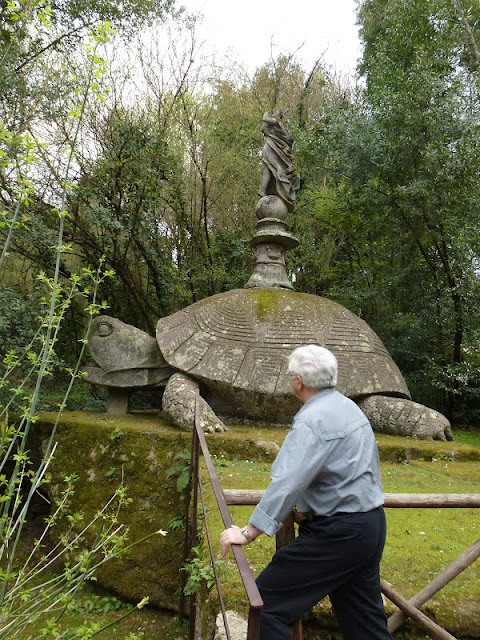So we were up early Saturday morning, caught a train to Viterbo, rented a car and headed towards our accommodation which was in a small community called Attilignano, about 30 miles from Viterbo. On our way we did some touring. Our focus was to stay off the Autostrad and take only the smaller roads and byways. Driving on Italian roads is not difficult. They are clearly and frequently posted with speed limits, directional signage to towns, dips and humps noted, traffic lights and crossroads signed with distance to same. There are five different speed limits in Italy. On multi lane roads like the Autostrad, 110kph is not only expected but if you can't maintain it, you could be fined. Scooters and cyclists are not allowed on the Autosrand. Primary highways, two way with paved shoulders, are posted at 90kph. Secondary highways, 2 way with no shoulders (our choice), are 70kph. In communities the speed limit is 50kph, and around congested area, schools, etc. 30kph is the speed.
We had no trouble finding where we had to go, unless signs were missed because the navigator was too busy gawking and not paying attention to her job! The drivers though now, a whole other story, can be impatient and all tend to drive like they are Formula 1 drivers, not paying particular attention to center lines, speed limits and no passing signs; taking curves deep and on the inside; riding your bumper if you are slower than they want, and clearly feel that pesky road rules are only meant as suggestions.
The first community we reached was Bagnaia, and it was not until we were through it that we realized it was one of those hilltop towns often described when Tuscany is talked about. We were aware that the town had some age to it, because as we drove through it, there was a traffic light controlling traffic thru a particularly narrow part. There was one way alternating traffic for about 5 or 6 blocks because the street was so narrow. No sidewalks for pedestrians, they had to keep an eye on the traffic and tuck themselves alongside the wall as traffic past, if necessary. We then crossed a bridge going down over a ravine to the other side and that is when we became aware of how this town was perched on the edge of a cliff.
I was unable to get a good picture as I was on the wrong side of the car and there was nowhere to pull over to get out and get a good shot. I did find one on the Internet that was taken in 1950's that is exactly the same as it looks today. Sorry for the poor quality.
Below, the one way street, note the doorway opens right into the street.
The next community we arrived at was Bomarzo. I had read about a place called "Sacro Bosco" (Sacred Wood) or more recently the "Parco dei Mostri" (Park of Monsters) that was located here. This was to be a complete surprise for Bill, as I had not told him word one about it. This is what we saw as we wend our way towards the park.
Hills and valleys stretched out below the town of Bomarzo
The town of Bomarzo as seen from the "Sacro Bosco"
Now, for the Sacro Bosco/Parco dei Mostri. The history/story is that in the 1500, one Pier Francesco Orsini commissioned a Mannerist wooded park, located at the bottom of a valley where the castle of Orsini was erected, and populated it with sculptures and small buildings divided among of the natural vegetation. It is one of the most suggestive examples of late Renaissance art in Italy. The park's name stems from the many larger-than-life sculptures, some sculpted in the bedrock, which populate this predominantly barren landscape. The park was intended not to please, but to astonish.
The park went into decline in the 19th and 20th century, but about 1970 a program was established to restore the gardens.
Now a look at some of the "Mostri"
Proteus - Glauco - child of 6 or 7 can stand in the mouth
Struggle between giants - about 20 ft tall
Turtle
Tourist Bill in front of turtle to show scale
Whale - sits in stream in front of and below turtle's head as if rising up to grasp him
Pegasus fountain
Nymphaneum and seats
A resting "Nymph"
Nymph Fountain
Leaning house
Inside the leaning house
More to come..............















No comments:
Post a Comment